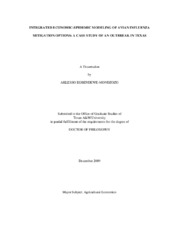| dc.contributor.advisor | McCarl, Bruce A. | |
| dc.creator | Egbendewe-Mondzozo, Aklesso | |
| dc.date.accessioned | 2011-02-22T22:23:55Z | |
| dc.date.accessioned | 2011-02-22T23:46:35Z | |
| dc.date.available | 2011-02-22T22:23:55Z | |
| dc.date.available | 2011-02-22T23:46:35Z | |
| dc.date.created | 2009-12 | |
| dc.date.issued | 2011-02-22 | |
| dc.date.submitted | December 2009 | |
| dc.identifier.uri | https://hdl.handle.net/1969.1/ETD-TAMU-2009-12-7438 | |
| dc.description.abstract | Recent World Animal Health Organization (OIE) reports on Avian Influenza (AI) outbreaks in Asia, Europe and Canada suggest that there is a nonzero probability that an
outbreak may occur anywhere in the world, including the US. To help evaluate possible policy in the face of such an event, this dissertation does an economic evaluation of the implications of using two mitigation strategies: one corresponding to the currently response strategy; and the other an OIE recommended one utilizing vaccination. To do this, the dissertation develops and uses an integrated economic-epidemic model. In this
effort, I first estimate the cost of an AI outbreak under a deterministic disease spread assumption where a new vaccination strategy and the current strategy are compared. Subsequently, I introduce risk in the model and construct 95 percent confidence intervals for
the outbreak costs, and I rank the outcomes of the alternative strategies using stochastic dominance criteria. In addition, during both phases, I develop and estimate the breakeven probability for an event where ex-ante fixed costs of vaccine stockpiling are
justified by the reduction in disease event damages.
Results under deterministic disease spread assumption suggest that the vaccination strategy lowers the cost of outbreaks as opposed to the current strategy. This
happens because vaccination reduces the number of culled and quarantined flocks. The study is conducted in three locations, yielding the finding that the costs of an outbreak vary depending on the densities of poultry flocks. I also find that when consumer
demand shifts due to the outbreak, the costs are much larger. Finally, I find that ex-ante
vaccine stockpiling is justified for all the sub-regions if the probability of outbreak
exceeds 0.07.
The stochastic disease spread assumption results also show that the vaccination
strategy dominates in first degree stochastic dominance sense. Consistent with stochastic
dominance results, the 95 percent confidence intervals have narrower ranges under the
vaccination strategy than without it. Finally, the distribution of the breakeven probability
for vaccine stocking has a mode of 0.07 and that the probability is accurate with 82 percent
likelihood. However, the threshold varies with the disease transmission parameters and
could reach up to 0.32. | en |
| dc.format.mimetype | application/pdf | |
| dc.language.iso | en_US | |
| dc.subject | Economic-epidemic modeling | en |
| dc.subject | Avian Influenza mitigation strategies | en |
| dc.subject | Ex-ante versus Ex-post decision making | en |
| dc.title | Integrated Economic-Epidemic Modeling of Avian Influenza Mitigation Options: A Case Study of an Outbreak in Texas | en |
| dc.type | Book | en |
| dc.type | Thesis | en |
| thesis.degree.department | Agricultural Economics | en |
| thesis.degree.discipline | Agricultural Economics | en |
| thesis.degree.grantor | Texas A&M University | en |
| thesis.degree.name | Doctor of Philosophy | en |
| thesis.degree.level | Doctoral | en |
| dc.contributor.committeeMember | Bessler, David | |
| dc.contributor.committeeMember | Boadu, Frederick O. | |
| dc.contributor.committeeMember | Elbakidze, Levan | |
| dc.contributor.committeeMember | Li, Qi | |
| dc.type.genre | Electronic Dissertation | en |
| dc.type.material | text | en |


